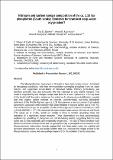Files in this item
Transient deep-water oxygenation recorded by rare Mesoproterozoic phosphorites, South Urals
Item metadata
| dc.contributor.author | Stüeken, Eva E. | |
| dc.contributor.author | Kuznetsov, Anton B. | |
| dc.contributor.author | Vasilyeva, Irina M. | |
| dc.contributor.author | Krupenin, Mikhail T. | |
| dc.contributor.author | Bekker, Andrey | |
| dc.date.accessioned | 2022-05-05T23:50:02Z | |
| dc.date.available | 2022-05-05T23:50:02Z | |
| dc.date.issued | 2021-07-15 | |
| dc.identifier | 274171182 | |
| dc.identifier | 227def84-745b-452a-85ff-1b53992b46cd | |
| dc.identifier | 85105360406 | |
| dc.identifier | 000654275400004 | |
| dc.identifier.citation | Stüeken , E E , Kuznetsov , A B , Vasilyeva , I M , Krupenin , M T & Bekker , A 2021 , ' Transient deep-water oxygenation recorded by rare Mesoproterozoic phosphorites, South Urals ' , Precambrian Research , vol. 360 , 106242 . https://doi.org/10.1016/j.precamres.2021.106242 | en |
| dc.identifier.issn | 0301-9268 | |
| dc.identifier.other | RIS: urn:C4AE8B5DFCFD6E36D9E336417691290F | |
| dc.identifier.other | ORCID: /0000-0001-6861-2490/work/93894747 | |
| dc.identifier.uri | https://hdl.handle.net/10023/25299 | |
| dc.description | EES acknowledges start-up funds from the School of Earth & Environmental Sciences at the University of St Andrews. The isotope work was supported by RFBR project 19-05-00623. This contribution is dedicated to Galina Ovchinnikova, a pioneer in U-Pb dating of sedimentary apatite at IPGG RAS (St. Petersburg, Russia). | en |
| dc.description.abstract | The Mesoproterozoic deep ocean is thought to have been largely anoxic, dominated by ferruginous conditions. Phosphate was scavenged from the water column by iron oxyhydroxides, and dissolved nitrate was rapidly reduced along the redoxcline. Primary productivity was therefore generally low, and eukaryotic life was restricted to oxic marine margins. This model is supported by new nitrogen isotope data from the Lower Riphean (ca. 1.55 Ga) strata of the South Ural Mountains, where we find evidence for strong redox stratification, coupled with low organic carbon content. In contrast, unconformably overlying siliciclastic sedimentary rocks of Middle Riphean age (ca. 1.33 Ga) preserve a rare occurrence of apatite concretions, associated with relatively high concentrations of organic carbon (up to 4 wt%). The Pb-Pb isochron age for the apatite concretions of the Zigazino-Komarovo Formation is 1330 ± 20 Ma (MSWD = 3.7). We measured nitrogen isotope ratios across this interval and found δ15N values up to + 7.6‰, which are similar to those in modern upwelling zones and indicative of a significant nitrate reservoir. These observations are most parsimoniously explained by upwelling of phosphate- and nitrate-bearing waters, suggesting that the deep ocean was at least regionally and temporarily oxygenated. The lack of redox-sensitive trace element enrichment in these strata and the general scarcity of apatite accumulations in the Mesoproterozoic sedimentary record suggest that oxic deep-waters were not a global and persistent phenomenon, but our results confirm that oxic, nutrient-rich refugia existed in Mesoproterozoic oceans and were perhaps important for the radiation of early eukaryotes. | |
| dc.format.extent | 14 | |
| dc.format.extent | 1617481 | |
| dc.language.iso | eng | |
| dc.relation.ispartof | Precambrian Research | en |
| dc.subject | Mesoproterozoic | en |
| dc.subject | Phosphorites | en |
| dc.subject | Nitrogen isotopes | en |
| dc.subject | Oxygenation | en |
| dc.subject | Ural Mountains | en |
| dc.subject | G Geography (General) | en |
| dc.subject | NDAS | en |
| dc.subject | SDG 14 - Life Below Water | en |
| dc.subject | AC | en |
| dc.subject.lcc | G1 | en |
| dc.title | Transient deep-water oxygenation recorded by rare Mesoproterozoic phosphorites, South Urals | en |
| dc.type | Journal article | en |
| dc.contributor.institution | University of St Andrews. School of Earth & Environmental Sciences | en |
| dc.contributor.institution | University of St Andrews. St Andrews Centre for Exoplanet Science | en |
| dc.identifier.doi | https://doi.org/10.1016/j.precamres.2021.106242 | |
| dc.description.status | Peer reviewed | en |
| dc.date.embargoedUntil | 2022-05-06 |
This item appears in the following Collection(s)
Items in the St Andrews Research Repository are protected by copyright, with all rights reserved, unless otherwise indicated.

